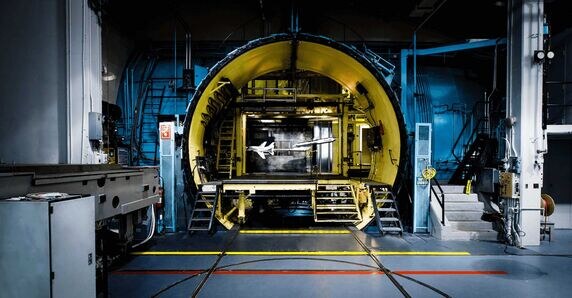


Wind tunnel tests, especially transonic wind tunnel testing, are indispensable tools in the quest for faster, more efficient designs.
Wind tunnel testing has become an essential part of aerodynamic research and design, offering valuable insights into the behavior of air over various objects, particularly vehicles, aircraft, and even buildings. These tests provide engineers with the data they need to improve speed, efficiency, and overall performance. From aviation to motorsports, wind tunnels play a pivotal role in refining designs, helping engineers predict how their products will perform under real-world conditions.
Wind tunnels are controlled environments where air is made to flow over a model, simulating real-world conditions at different speeds. This allows engineers to study the interaction between air and the object, measuring how forces such as drag, lift, and downforce affect performance. This information is vital for designing vehicles and aircraft that can maximize speed, fuel efficiency, and stability.
In the early days of flight, wind tunnels were crucial for testing aircraft designs before they were put into production. They allowed engineers to fine-tune shapes to reduce drag and optimize lift. Over time, the technology has evolved, with modern wind tunnels offering highly detailed and accurate simulations. Today, they’re used in various industries, including automotive, aerospace, and even sports.
A critical phase of wind tunnel testing involves simulating airflow conditions that approach the speed of sound—this is known as transonic wind tunnel testing. When an object approaches the speed of sound, the air around it undergoes dramatic changes. Some areas of airflow will exceed the speed of sound, while others remain subsonic. This creates complex shockwaves and turbulent regions that can greatly affect an object’s performance.
Transonic wind tunnel testing is essential for designing aircraft and high-speed vehicles, where aerodynamic forces become highly nonlinear as the speed increases. The ability to precisely measure the impact of these forces allows engineers to optimize shapes for stability, speed, and fuel efficiency. The challenge is that small changes in design, shape, or angle of attack can have a disproportionate effect at transonic speeds. Therefore, wind tunnel tests at these speeds provide invaluable data for creating more efficient and faster designs.
In the aerospace industry, transonic wind tunnel testing plays a crucial role in the development of aircraft. Designers and engineers use these tests to identify drag reduction opportunities, understand shockwave formation, and predict performance at higher speeds. Wind tunnel tests allow for a deeper understanding of flow separation, a phenomenon that occurs when airflow detaches from the surface of an aircraft, leading to increased drag and reduced lift. Identifying and mitigating flow separation is key to improving performance and efficiency in both commercial and military aircraft.
The benefits of these tests extend beyond the design phase. Transonic wind tunnel testing can also be used to optimize existing aircraft, ensuring they remain competitive in terms of performance and fuel consumption. For instance, aircraft manufacturers may use wind tunnels to test modifications to the wings, fuselage, or other components to improve aerodynamics.
Wind tunnel testing is also vital in the automotive industry, particularly for motorsports, where aerodynamics is directly linked to speed and handling. Racing cars, for example, require highly specialized aerodynamic designs to achieve maximum downforce while minimizing drag. Wind tunnel testing allows teams to refine their car designs, testing different configurations of body shapes, wing angles, and undercarriages to find the most efficient balance.
As technology advances, so too does the capability of wind tunnel testing. Engineers are incorporating more sophisticated tools such as computational fluid dynamics (CFD) to complement wind tunnel data, allowing for faster, more accurate simulations. The combination of CFD and physical testing ensures that designs can be thoroughly evaluated before production begins, reducing the number of physical prototypes needed and accelerating the development process.
Wind tunnel tests, especially transonic wind tunnel testing, are indispensable tools in the quest for faster, more efficient designs. From aerospace to automotive industries, they help engineers fine-tune their products, improving everything from stability and speed to fuel efficiency. As technology evolves, the combination of wind tunnel testing and advanced computational techniques will continue to push the boundaries of performance, ensuring that the vehicles of the future are faster, more efficient, and more environmentally friendly.
